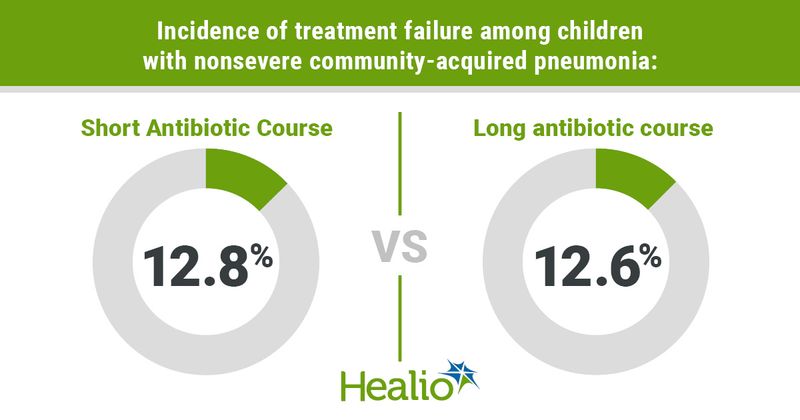Short-course antibiotic therapy appears effective for pediatric nonsevere pneumonia
Click Here to Manage Email Alerts
In children with nonsevere community-acquired pneumonia, or CAP, a shorter course of antibiotic therapy appeared comparable to a longer course, according to results of a systematic review and meta-analysis published in JAMA Pediatrics.
“Clinicians should consider prescribing a shorter course of antibiotics for the management of pediatric nonsevere CAP in accordance with antimicrobial stewardship principles,” Qinyuan Li, MD, of the department of respiratory medicine at Children’s Hospital of Chongqing Medical University in China, and colleagues wrote.

Li and colleagues included data from nine randomized clinical trials published through March 31, 2022, of 11,143 children (98% aged 2 months-59 months; 58% boys) with nonsevere CAP. The trials evaluated whether short-course therapy was noninferior to longer-course therapy by comparing regimens of 3 days vs. 5 to 10 days or 5 days vs. 7 to 10 days.
Once they obtained all relevant studies, researchers used random-effects models to combine the data and Grading of Recommendations Assessment, Development and Evaluation (GRADE) to give the study evidence a grade based on quality.
Treatment failure — which researchers classified as persistent pneumonia; new danger signs of CAP, such as lethargy, unconsciousness, seizures or the inability to drink; elevated temperature after treatment; change of antibiotic; hospitalization; death; missing more than three study drug doses, loss to follow-up or withdrawal — served as the study’s primary endpoint.
Primary endpoint
Eight studies involving 10,662 patients reported data on treatment failure.
Overall, 12.8% of children assigned a shorter antibiotic course met this endpoint compared with 12.6% of children assigned a longer antibiotic course.
Based on treatment failure results from studies with high-quality evidence, researchers found that a shorter course of oral antibiotics was noninferior to a longer course (RR = 1.01; 95% CI, 0.92-1.11; risk difference, [RD] = 0; 95% CI, –0.01 to 0.01; I2 = 0%).
Subgroup analysis of children aged 2 to 59 months showed similar results (RR = 1.01; 95% CI, 0.91-1.11; RD = 0; 95% CI, 0.01 to 0.01; I2 = 0%); however, noninferiority between treatment courses was not observed when evaluating children aged 5 years and older (RR = 2.07; 95% CI, 0.76-5.63; RD = 0.15; 95% CI, –0.05 to 0.36).
Researchers further observed that a 3-day course was noninferior to a 5-day course (RR = 1.01; 95% CI, 0.91-1.12; I2 = 0%). Similarly, 5 days of antibiotics was noninferior to 10 days (RR = 0.87; 95% CI, 0.5-1.53; I2 = 0%). Results were comparable when analyzing 5 days vs. 7 days of treatment but not between a 3-day and 10-day antibiotic course.
Secondary endpoints
Researchers also evaluated for relapse, adverse events, antimicrobial resistance, patients’ or their caregivers’ absenteeism and direct medical costs between the treatment courses.
Of the six studies that reported on relapse among 9,447 children, a shorter course of antibiotics appeared again noninferior to a longer course (RR = 1.12; 95% CI, 0.94-1.34; RD = 0; 95% CI, 0-0.01; I2 = 0%).
Compared with children receiving a long antibiotic course, researchers found that children receiving a short course had a decreased risk for gastroenteritis (RR = 0.79; 95% CI, 0.66-0.95) and rash (RR = 0.79; 95% CI, 0.65-0.97) based on five studies including 4,475 children.
Of the four studies that addressed antimicrobial resistance (n = 2,876), researchers found mixed results.
Only one study touched on caregiver work absenteeism, demonstrating that it was lower in the 5-day group compared with the 10-day group (incident RR = 0.74; 95% CI, 0.65-0.84), with comparable child absenteeism between the two groups.
Further, only one study (n = 2,188) included treatment-related costs and described that mean direct medical costs for treating 1,000 cases of pneumonia was $1,100 in the 3-day course group, whereas it was $1,250 in the 5-day course group.
“We think our review helps fill an evidence gap and provides a basis for evidence-based decision-making,” Li and colleagues wrote. “Guideline developers and clinicians from [low- and middle-income] countries could consider shifting to a 5-day course for the management of children with CAP. Although current evidence supports the shorter courses, the optimal duration of antibiotic therapy is not ‘one size fits all’ but should be individualized and consider pathogen factors and patients’ response to treatment.
“However, in clinical practice, knowing the true pathogen responsible for CAP and treating CAP according to the patient’s response are challenging,” the researchers added. “Future research is needed to promote the individualization of antimicrobial therapy for pediatric CAP.”
